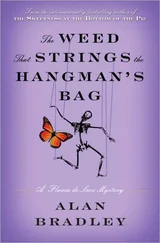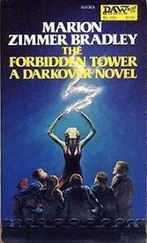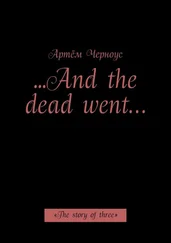“Oh, Miss Lavinia,” she said in a weak, exhausted voice, “Miss Aurelia. How awfully good of you to come.”
She stuck out a pale hand and touched each of them in turn on the forearm.
As she turned her head Flavia-wards, she gave me such a glare!
Feely had the knack of being able to screw one side of her face into a witchlike horror while keeping the other as sweet and demure as any maiden from Tennyson. It was, perhaps, the one thing I envied her.
“We brought these, dear,” Miss Aurelia said, thrusting the flowers at Feely. “They’re immortelle . Xeranthemum. They’re said to represent, you know, the Resurrection and the Life. They’re from our greenhouse.”
Feely took the flowers and sandwiched herself between the sisters as if for support, and was already moving with them into the foyer, leaving me alone on the doorstep to face what Daffy would call the madding crowd.
I was taking a deep breath, determined to do my best, when a voice at my ear said, “I’ll look after this, Miss Flavia.”
It was Dogger. And, as always, in the nick of time.
With a grateful and yet bereaved smile, since we were still on public display, I turned and floated wistfully into the house. In the foyer, I took to my heels and was up the east staircase like a rocket.
“The resurrection and the life,” Miss Aurelia had said.
There it was again! From the Apostle’s Creed: “… the resurrection of the body and the life everlasting.”
I recalled instantly my own thought: “I have restored my mother to life through the magic of chemistry.”
After developing the ciné film upon which Harriet’s images appeared, those words had rung out in my mind like Christmas bells. Something else, too, had chimed: the sound of the inner shiver which indicated that something unknown was being stored up for a later time.
Now it came shooting with full awareness back into my brain.
I would bring my mother back to life! And this time, it would not be just a dopey dream, but an actual scientific accomplishment.
There was so much to do—and so precious little time.
NINE
FATHER HAD DECREED THAT we, the immediate family, would take turns standing watch over Harriet. He himself would take the first shift of six hours, he had decided, from two until eight o’clock. Feely, as next oldest, would serve from eight till two in the morning, followed by Daffy until eight A.M., at which time I was to take over until two in the afternoon. Aunt Felicity had at first been written off on grounds of age.
“Nonsense, Haviland!” she had told him. “I’m as capable as you are. More, when you come right down to it. You must not deny me my vigil.”
And so the rota had been rearranged. We each would be assigned a watch of 4.8 hours, which came out neatly, as Daffy pointed out, at 4 hours and 48 minutes per person.
Aunt Felicity would stand watch from 2:00 this afternoon until 6:48 in the evening; Father from 6:48 until 11:36; Feely from 11:36 until 4:24; Daffy from 4:24 until 9:12 in the morning; and me from then until 2:00 tomorrow afternoon, the time of the funeral.
It was a typical de Luce solution: logical beyond question, and yet, at the same time, mad as a March hare.
There was just one problem: In order to carry out the work I intended to do, my watch needed to be in the latest hours of the night and the earliest hours of the morning.
In short, I needed to switch shifts with Feely.
Feely, however, was busy soaking up sympathy from the Misses Puddock and I didn’t want to deprive her of that. I’d tackle her later about swapping shifts.
Meanwhile, I needed to prepare for what might well prove to be the greatest chemical experiment of my life. There wasn’t an instant to lose.
Upstairs in my laboratory I riffled through my notebook. I knew I had written down the details somewhere.
Ah, yes—here it was: Hilda Silfverling, a Fantasy , by Lydia Maria Child. Daffy had once entertained us with it at the breakfast table: the tale of a poor, unfortunate woman in Sweden who was about to have her head chopped off after being falsely accused of infanticide.
I had never forgotten the learned chemist of Stockholm in the story, “whose thoughts were all gas, and his hours marked only by combinations and explosions.”
To be perfectly honest, it was the only part of the tale that had really interested me. This scientist, whose name was never given so that I could look him up in Scientific Lives , had discovered a process of artificial cold by which he could suspend animation in living creatures. Even more importantly, he had discovered a way to restore the subject, Hilda Silfverling in this case, to life whenever he wished.
“Is that really possible?” I had asked.
“It’s fiction,” Daffy had said.
“I know. But couldn’t it be based on truth?”
“All writers would have you believe that their stories are based on truth, but the word ‘fiction’ is formed from a word meaning ‘to contrive.’ You, in particular, ought to relate to that.”
I bit my tongue, hoping she would continue, and she did.
“Take Jack London, for instance,” she said. My sister loved to show off.
“What about him?”
“Well, he wrote what amounted to essentially the same story. ‘ A Thousand Deaths ,’ it was called. About a man whose occupation was allowing himself to be killed in as many different ways as you can imagine, then brought back to life by his father, who was something of a mad scientist.”
“Like Dr. Frankenstein!” I said excitedly.
“Exactly. Except that this fool let himself be poisoned, electrocuted, drowned, strangled, and suffocated. Among other things,” she added.
Now this was my kind of reading!
“Where can I find a copy?”
“Oh, in the library, somewhere,” Daffy had sniffed, waving me away with an impatient hand.
It had taken quite a while, but in the end, I had found it almost by accident in a rather grubby penny book.
And what a disappointment! Rather than giving any specific details about his many deaths and resurrections, the author allowed his character to ramble on vaguely about magnetic fields, polarized light, nonluminous fields, electrolysis, molecular attraction, and a hypothetical force called apergy, which was claimed to be the opposite of gravity.
What a load of bloody codswallop!
I could have come up with a better theory of resurrection from the dead with both hands tied behind my back at the bottom of a pond in a potato sack.
In fact, I did, even though I couldn’t take full credit for it myself.
I had been passing the time of day with Dogger in the greenhouse, trying to think of ways to ask him about his imprisonment with Father in a Japanese prisoner-of-war camp, but without actually seeming to.
“Dogger,” I had asked with a burst of sudden inspiration, “do you know anything about jiujitsu?”
He pulled a root-bound plant from its pot and prodded it tenderly with his trowel. The root ball looked like a Martian’s brain.
“Perhaps,” he said at last, “a little.”
I tried to breathe through my ears so as not to break his fragile train of thought.
“Long ago, before I—”
“Yes?”
“As a student—” Dogger said, picking at the roots with his fingers as if he were unraveling the strands of the Gordian knot, “as a student, I had occasion to study for a time the Kano system of jiujitsu. It was popular in my day.”
“Yes?” I couldn’t think of anything else to say.
“I was much interested in the art of kuatsu, that branch of the subject which deals with the lethal blows, but much more important, the healing and restoration of life to those who may have suffered them.”
Читать дальше












